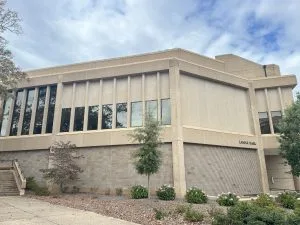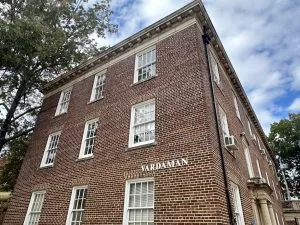
Every day, thousands of students at the University of Mississippi attend classes in various buildings around campus. They walk in and out without ever knowing the history behind them. But how would students feel knowing that these buildings, the names of which are known throughout campus, are named after racists?
While UM has no doubt taken strides towards diversity and inclusion, some things have been put on the backburner.
In 2017, under former UM Chancellor Jeffrey Vitter, the Chancellor’s Advisory Committee on History and Context issued a report “recommending campus sites, including monuments, buildings and street names, to be contextualized to better explain the environments in which they were created or named and how those environments compare to our core institutional values.”
Among these buildings were Paul B. Johnson Commons, Vardaman Hall, Barnard Observatory, Longstreet Hall, Lamar Hall and George Hall. Vitter supported multiple recommendations made by the committee report.
Charles Ross, professor of history and African American studies and member of the CACHC, was quick to say “no” when asked if he thinks most students are aware of the history behind some of these buildings.
“They just know the names of buildings. I guarantee if you go out and ask 100 students the results would produce that the vast majority of them are not aware of the history behind the names of those individuals on the buildings,” Ross said. “Students probably would be very surprised if they found it out.”
The Daily Mississippian asked 10 students at random if they were aware of any racist histories connected to these buildings, and all 10 students said no.
“I had no idea of the background and history of these buildings, and it is surprising that I have never even heard about it,” Kimber Spelts, a junior business major, said.

Vardaman Hall was named in honor of James Vardaman, the governor of Mississippi from 1904 to 1908. He is most known for his extreme views on race, as he believed that African Americans did not deserve education and should remain in economic servitude.
Ralph Eubanks, faculty fellow and writer-in-residence in the Center for the Study of Southern Culture, elaborated on Vardaman’s racist views.
“Vardaman made blatantly racist statements, including publicly stating that African Americans were ‘lazy, lying, lustful animal(s), which no amount of training can transform into a tolerable citizen,’” Eubanks said. “I believe there is no excuse for that name to remain on a building at this university.”
On the Ole Miss Catalog for the university’s buildings, Vardaman Hall’s description is two sentences long, with no mention of Vardaman’s racism. However, there is a separate page of historical contextualization on the UM library website that gives a short description of his racist actions and beliefs.
In 2017, Chancellor Vitter issued remarks to the CACHC on the renaming process of buildings like Vardaman Hall.
“When the fundraising and renovation are complete in a couple of years, we will seek IHL approval for a renaming,” he said.
Six years later, the name remains.
Another landmark building on campus is Lamar Hall, named after Lucius Q.C. Lamar. Lamar was an ardent supporter of slavery, owning more than 30 slaves in 1860; he helped draft Mississippi’s Ordinance of Secession from the United States before the Civil War. After the war, he taught at UM, was elected a U.S. congressman and senator from the state and ultimately served as a U.S. Supreme Court justice.
Despite his racist past, Lamar was one of only eight leaders to be praised in John F. Kennedy’s “Profiles In Courage” for his speech on reconciling the North and South after the Civil War. His recognition at such a national level disguised the active role he had in obstructing Reconstruction efforts after the Civil War.
There is a contextualization plaque in front of Lamar Hall that briefly mentions Lamar’s racist history. The Daily Mississippian could not find any more information regarding Lamar’s prejudice anywhere on UM’s website. In fact, the only two buildings whose racist histories are contextualized on UM’s website are Vardaman Hall and Johnson Commons.
Buildings also named after adamant supporters of slavery are Longstreet Hall, George Hall and Barnard Observatory. There are context marker plaques in front of these buildings as well, but little information is available online regarding the history of the men for whom they are names.
“I think the university does a horrible job of recognizing how these men contributed to the culture of segregation and racism toward African Americans in the state of Mississippi,” Harrison Dillard, a junior history major, said. “There needs to be an acknowledgment of how the university served as a breeding ground for Mississippi elites to develop such racist ideas and put them into practice once they got into politics.”
The question now is how should the university move forward? When discussing whether the buildings mentioned should have the names changed altogether, Ross was in support.
“I do think that those names could be changed because the process of naming buildings, in many cases, took place in a time period where the university was not inclusive,” Ross said. “Now that we are moving to a more inclusive kind of institution, you have to look back at vestiges that were produced during a time period that we did not have everyone being able to weigh in on whether or not something is insensitive and makes individuals feel as though they are not a part of this institution.”
Although UM has yet to rename these buildings, it has undertaken the process before. In 2018, the former Meek School of Journalism and New Media became the School of Journalism and New Media when Ed Meek’s name was removed after he published a racially incendiary Facebook post. Meek, after being urged by the university, suggested UM remove his name from the school, and it took less than a year for the university to do so.
To bolster UM’s values of inclusion, Ross proposed the university undertake a process of renaming.
“There are a number of other individuals that have made significant contributions to help make this state better,” Ross said. “Their names could replace individuals that came from a time period where they took strong positions that did not favor total inclusion.”
Samantha Case, a junior history major, believes that the best way for the university to enact change is to break the silence around the conversation.
“I think the best way to go about making students aware of the university’s complicated past is by creating open dialogues where students, faculty and staff can address their concerns,” Case said.
When asked how the university reconciles these building names with current attitudes, Jacob Batte, director of news and media relations for the university, referenced the contextualization plaques.
“The university’s approach includes teaching and fostering learning through a number of contextualization plaques located throughout the campus that explain the environment in which a building or area of campus was created or named,” Batte said.
Batte explained that the university is still working to change the names but did not specify a timeline or plan.
Ross feels that renaming the buildings is the best message the university could send to show that it has moved past its racist roots.
“One of the benefits that the university would gain from making these changes is that it would help send a message, particularly to African American students, in a way that would make them feel more connected,” Ross said. “What would that do for publicity in terms of sending a message about trying to rectify things that were in the past that weren’t right? There would be a lot of mileage from potentially doing something like this.”
Dillard echoed that renaming the buildings is the only solution.
“Honestly, no plaque or statement would truly convey how detrimental these men were toward African American progress, and the university should remove the names from the buildings,” Dillard said.


